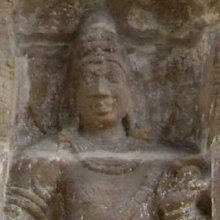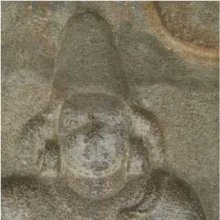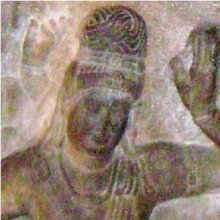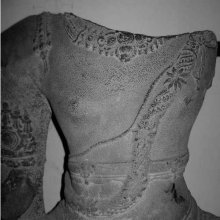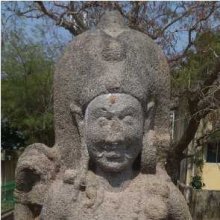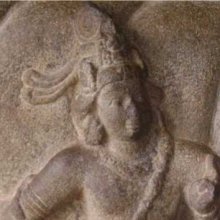Yajnopavita, Yajñopavīta, Yajna-upavita: 25 definitions
Introduction:
Yajnopavita means something in Hinduism, Sanskrit, Marathi, Hindi. If you want to know the exact meaning, history, etymology or English translation of this term then check out the descriptions on this page. Add your comment or reference to a book if you want to contribute to this summary article.
Alternative spellings of this word include Yagyopavit.
Images (photo gallery)
(+11 more images available)
In Hinduism
Pancaratra (worship of Nārāyaṇa)
Source: SriMatham: Vaiṣṇava Iconology based on Pañcarātra ĀgamaSacred Thread (yajñopavitam):—All initiated members of the 3 twice-born castes wear the sacred thread draped over the left shoulder and falling upon the right hip. It indicates that the one who wears it is committed to the control of body, speech and mind.
brahma-sūtram trivṛt svaram |
The sacred thread (yajñopavitam) symbolizes the syllable AUM, by its three strands. (S.B. 12.11.;2).

Pancaratra (पाञ्चरात्र, pāñcarātra) represents a tradition of Hinduism where Narayana is revered and worshipped. Closeley related to Vaishnavism, the Pancaratra literature includes various Agamas and tantras incorporating many Vaishnava philosophies.
Purana and Itihasa (epic history)
Source: archive.org: Shiva Purana - English TranslationYajñopavīta (यज्ञोपवीत) [=yajñopavītaka?] refers to a “sacred thread” and is used to describe Śiva, according to the Śivapurāṇa 2.3.30 (“The Celebration of Pārvatī’s Return”).—Accordingly, as Brahmā narrated to Nārada: “[...] Pārvatī became unconscious. She saw Śiva’s handsome form, bearing trident and other symbols before her vision. He had smeared the ashes all over His body. He was wearing a garland of bones. His face was beaming with his shining three eyes. He had the sacred thread (yajñopavītaka) of a serpent. [...]”.
Source: Cologne Digital Sanskrit Dictionaries: The Purana IndexYajñopavīta (यज्ञोपवीत).—The sacred thread;1 of Śiva, skin of Vyāla.2

The Purana (पुराण, purāṇas) refers to Sanskrit literature preserving ancient India’s vast cultural history, including historical legends, religious ceremonies, various arts and sciences. The eighteen mahapuranas total over 400,000 shlokas (metrical couplets) and date to at least several centuries BCE.
Shaivism (Shaiva philosophy)
Source: academia.edu: KāpālikasYajñopavīta (यज्ञोपवीत, “sacred thread”).—In addition to carrying the skull-bowl, they wore a sacred thread (yajñopavīta) made of human hair obtained from corpses, and they adorned themselves with ornaments mostly made of human bones: a necklace, earrings, bracelets or armlets, and a hair jewel (śikhāmaṇi).
Source: Brill: Śaivism and the Tantric TraditionsYajñopavīta (यज्ञोपवीत) refers to a “sacred thread”, according to the Siddhayogeśvarīmata chapter 10.—Accordingly, “[Bhairava spoke]:—[...] The male or female practitioner, with his/her mind focused on the mantra, should perform worship according to prescriptions and then undertake the vow. [In the first of these] all his limbs covered with ashes, the practitioner is to observe silence and should wear a white garment; he should be of good understanding. He must have a white sacred thread (sita-yajñopavīta), he should be free from desire and established in self-restraint.”.
Source: SOAS University of London: Protective Rites in the Netra TantraYajñopavīta (यज्ञोपवीत) refers to a “sacred thread”, according to the Netratantra of Kṣemarāja: a Śaiva text from the 9th century in which Śiva (Bhairava) teaches Pārvatī topics such as metaphysics, cosmology, and soteriology.—Accordingly, [verse 9.19cd-26, while instructing to visualize Sadāśiva in order to worship the formless Amṛteśa]—“[He] resembles the swelling moon, a heap of mountain snow. Five-faced, large-eyed, ten-armed, [and] three-armed, [he] has a serpent as a sacred thread (nāga-yajñopavīta). He is covered in a garment made of tiger skin. [He] sits in the bound lotus pose atop a white lotus, [holding] a trident, blue lotus, arrow, rudrākṣa, [and] a mallet. [...]”.

Shaiva (शैव, śaiva) or Shaivism (śaivism) represents a tradition of Hinduism worshiping Shiva as the supreme being. Closely related to Shaktism, Shaiva literature includes a range of scriptures, including Tantras, while the root of this tradition may be traced back to the ancient Vedas.
Shilpashastra (iconography)
Source: Shodhganga: Vaisnava Agamas And Visnu ImagesYajñopavīta (यज्ञोपवीत) refers to the fashion of “wearing Yajñasūtra over the left shoulder across the body”, as defined in treatises such as the Pāñcarātra, Pādmasaṃhitā and Vaikhānasa-āgamas, extensively dealing with the technical features of temple art, iconography and architecture in Vaishnavism.—Yajñasūtra, also known as Yajñopavīta, is the sacred thread worn by Hindus of the higher classes (twice born), etymologically Yajñasūtra is the thread of yajña meant for rituals. Yajñopavīta refers to the fashion of wearing it over the left shoulder across the body. This very special symbolic thread is represented in different ways according to the status of the icon and the different materials it may be composed of (chord, antelope skin etc.).
Banerjea observes: “The Yajñopavīta or sacred thread which is invariably worn by the male members of the twice-born is found on the icons of the gods from the Gupta period onwards; in the earlier icons it is not usually to be found. In mediaeval sculptures, what appear to be the representation of a jewelled Yajñopavīta sometime accompanies that of the cotton one: all this, of course, is placed in the upavītī fashion. i.e., it encircles the tor o from the top of the left shoulder and below the right arm. Sometimes the kin of an antelope (kṛṣṇasāra) is thrown over the body of such deities like Nara and Nārāyṇa”
Gopinath Rao states: “In almost all the later representations of Hindu gods and goddesses we may see the Yajñopavīta running across the chest from left to right”.

Shilpashastra (शिल्पशास्त्र, śilpaśāstra) represents the ancient Indian science (shastra) of creative arts (shilpa) such as sculpture, iconography and painting. Closely related to Vastushastra (architecture), they often share the same literature.
Shaktism (Shakta philosophy)
Source: Google Books: ManthanabhairavatantramYajñopavīta (यज्ञोपवीत) refers to a “sacred thread” and represents one of the various insignias (i.e., mudrās) worn by a Kāpālika, according to the Āgamaprāmāṇya.—The Kāpālika, as his name—‘Skull Bearer’—implies, carried a skull as part of his penance modelled on that prescribed for having murdered a Brahmin. Along with the skull he was to wear six insignias, namely, a necklace (kuṭhikā), neck ornament (rucaka), earrings (kuṇḍala), crest jewel (śikhāmaṇi), ashes (bhasma) and sacred thread (yajñopavīta). These are described by Yāmunācārya in his Āgamaprāmāṇya and by Rāmānuja who draws from him in his commentary on the Brahmasūtra. The wearing of similar insignia was common practice amongst Buddhist Tantric ascetics who were inspired in their own way by the same model.

Shakta (शाक्त, śākta) or Shaktism (śāktism) represents a tradition of Hinduism where the Goddess (Devi) is revered and worshipped. Shakta literature includes a range of scriptures, including various Agamas and Tantras, although its roots may be traced back to the Vedas.
General definition (in Hinduism)
Source: Google Books: The Hindu-Buddhist Sculpture of Ancient Kashmir and its InfluencesThe yajñopavīta or sacred thread, which is single-stranded, compares with the single or multi-stranded amulet cord of a Gandhāra Bodhisattva, though it falls further down the body. It also resembles those worn by Brahmins depicted in Gandhāra sculpture, usually single-stranded, as well as those seen on some depictions of the Iranian god Oēshō on Kuṣāṇa coins, later assimilated into images of Śiva, but is more slender in both cases.
Source: archive.org: Vedic index of Names and SubjectsYajñopavīta (यज्ञोपवीत) denotes the ‘wearing of the Brahminical thread over the left shoulder at the sacrifice’, and is mentioned as early as the Taittirīya-brāhmaṇa.
Source: archive.org: South Indian Festivities (hinduism)Yajñopavīta (यज्ञोपवीत).—The sacred thread is called in Sanskrit Yajnopavitam (Yajna=sacrifice and upavitam=thread, i.e., the thread consecrated by a sacrifice). It consists of three strands of cotton, each strand formed by three or nine threads. The cotton with which a thread is made, must be gathered from the plant by the hand of a Brahmana and carded and spun by persons of the same caste. It is hung on the left shoulder and falls on to the right hip. Out of the four castes the Brahmans, Ksatrivas and Vaisyas are entitled to wear it. A child between the ages of 5 to 12 or 13 years is invested with the sacred thread when a ceremony is performed. This gives the neophyte a right to appear before his preceptor to study the vedas and acquire knowledge.
The triple cord symbolises, according to some authorities, (1) the three attributes of the Deity, i.e., creation, preservation and destruction (Brahma, Vishnu and Siva), and (2) body, mind and speech and the control over all of them.
Source: Oxford Reference: A Dictionary of HinduismDressing the deity (mūrti) in a new sacred thread—one of the sixteen offerings or services (upacāras) which are component parts of pūjā.
Source: WikiPedia: HinduismThe "sacred thread" (Sanskrit: यज्ञोपवीतम् yajñopavītam or upavīta) is a thin cord, composed of three cotton strands. The three strands symbolize different things in various regions. For example, among Tamil Hindus, each strand is for each of the three trinity of goddesses (Parvati, Lakshmi and Saraswati)
The sacred Yajñopavītam is known by many names (varying by region and community), such as Bratabandha, Janivāra, Jandhyam, Poita, Pūṇūl, Janeu, Lagun, Yajnopavita, Yagyopavit, Yonya and Zunnar. The other Sanskrit term for it is Avyanga.
Languages of India and abroad
Marathi-English dictionary
Source: DDSA: The Molesworth Marathi and English Dictionaryyajñōpavīta (यज्ञोपवीत).—n (S) The sacrificial thread worn by Brahmans.
Source: DDSA: The Aryabhusan school dictionary, Marathi-Englishyajñōpavīta (यज्ञोपवीत).—n The sacrificial thread.
Marathi is an Indo-European language having over 70 million native speakers people in (predominantly) Maharashtra India. Marathi, like many other Indo-Aryan languages, evolved from early forms of Prakrit, which itself is a subset of Sanskrit, one of the most ancient languages of the world.
Sanskrit dictionary
Source: DDSA: The practical Sanskrit-English dictionaryYajñopavīta (यज्ञोपवीत).—the sacred thread worn by members of the first three classes (and now even of other lower castes) over the left shoulder and under the right arm; see Manusmṛti 2.63; वामांसावलम्बिना यज्ञोपवीतेनोद्भासमानः (vāmāṃsāvalambinā yajñopavītenodbhāsamānaḥ) K.; कौशं सूत्रं त्रिस्त्रिवृतं यज्ञोपवीतम् (kauśaṃ sūtraṃ tristrivṛtaṃ yajñopavītam) ...... Baudhāyana; (originally yajñopavīta was the ceremony of investiture with the sacred thread).
Derivable forms: yajñopavītam (यज्ञोपवीतम्).
Yajñopavīta is a Sanskrit compound consisting of the terms yajña and upavīta (उपवीत).
Source: Cologne Digital Sanskrit Dictionaries: Shabda-Sagara Sanskrit-English DictionaryYajñopavīta (यज्ञोपवीत).—n.
(-taṃ) The sacrificial cord, originally worn by the three principal casts of Hindus: at present from the loss of the pure Kshetriya and Vaiśya casts in Bengal, confined to the Brahminical order. E. yajña sacrifice, upavīta thread.
Source: Cologne Digital Sanskrit Dictionaries: Cappeller Sanskrit-English DictionaryYajñopavīta (यज्ञोपवीत).—[neuter] the investiture with the sacrificial cord or the [substantive] cord itself.
Source: Cologne Digital Sanskrit Dictionaries: Monier-Williams Sanskrit-English DictionaryYajñopavīta (यज्ञोपवीत):—[from yajña > yaj] n. the investiture of youths of the three twice-born castes with the sacred thread or (in later times) the thread itself (worn over the left shoulder and hanging down under the right; originally put on only during the performance of sacred ceremonies but its position occasionally changed cf. prācīnāvītin, nivītin; in modern times assumed by other castes, as by the Vaidyas or medical caste in Bengal; cf. upanayana and, [Indian Wisdom, by Sir M. Monier-Williams 192]), [Taittirīya-brāhmaṇa] etc. etc.
Source: Cologne Digital Sanskrit Dictionaries: Yates Sanskrit-English DictionaryYajñopavīta (यज्ञोपवीत):—(taṃ) 1. n. The brāhmanical thread or cord.
Source: DDSA: Paia-sadda-mahannavo; a comprehensive Prakrit Hindi dictionary (S)Yajñopavīta (यज्ञोपवीत) in the Sanskrit language is related to the Prakrit words: Jaṇṇovaīya, Jaṇṇovavīya.
[Sanskrit to German]
Sanskrit, also spelled संस्कृतम् (saṃskṛtam), is an ancient language of India commonly seen as the grandmother of the Indo-European language family (even English!). Closely allied with Prakrit and Pali, Sanskrit is more exhaustive in both grammar and terms and has the most extensive collection of literature in the world, greatly surpassing its sister-languages Greek and Latin.
Hindi dictionary
Source: DDSA: A practical Hindi-English dictionaryYajñopavīta (यज्ञोपवीत) [Also spelled yagyopavit]:—(nm) the sacred thread traditionally worn by caste Hindus; one of the sixteen major [saṃskāra]s (also called [yajñopavīta saṃskāra]) wherein a young lad is given a sacred thread to wear for the first time.
...
Kannada-English dictionary
Source: Alar: Kannada-English corpusYajñōpavīta (ಯಜ್ಞೋಪವೀತ):—[noun] = ಯಜ್ಞಸೂತ್ರ [yajnasutra].
Kannada is a Dravidian language (as opposed to the Indo-European language family) mainly spoken in the southwestern region of India.
See also (Relevant definitions)
Partial matches: Yajna, Upavita.
Starts with: Yajnopavitadana, Yajnopavitadharanamantra, Yajnopavitadharanamantravidhi, Yajnopavitadharanavidhi, Yajnopavitaka, Yajnopavitamantra, Yajnopavitanashaprayashcittaprayoga, Yajnopavitanirmanapaddhati, Yajnopavitanirnaya, Yajnopavitanityadharanavidhi, Yajnopavitapaddhati, Yajnopavitapratishtha, Yajnopavitapratishthasancika, Yajnopavitasamskara, Yajnopavitasamskaravidhi, Yajnopavitavant, Yajnopavitavastra, Yajnopavitavat, Yajnopavitavidhi.
Ends with: Ayajnopavita, Nagayajnopavita, Raktayajnopavita, Sitayajnopavita, Vajrayajnopavita.
Full-text (+64): Savitrisutra, Yajnopavitin, Yajnasutra, Upanayana, Yajnopavitaka, Yagyopavit, Yajnopavitanashaprayashcittaprayoga, Yajnopavitadana, Yajnopavitadharanamantra, Yajnopavitanirmanapaddhati, Yajnopavitamantra, Yajnopavitapaddhati, Yajnopavitapratishtha, Yajnopavitavidhi, Yajnopavitapratishthasancika, Yajnopavitavat, Nagayajnopavitavat, Ekkiyopavitam, Shodashopacara, Upnayan.
Relevant text
Search found 34 books and stories containing Yajnopavita, Yajñopavīta, Yajna-upavita, Yajña-upavīta, Yajñōpavīta; (plurals include: Yajnopavitas, Yajñopavītas, upavitas, upavītas, Yajñōpavītas). You can also click to the full overview containing English textual excerpts. Below are direct links for the most relevant articles:
Garga Samhita (English) (by Danavir Goswami)
Verse 5.9.11 < [Chapter 9 - The Happiness of the Yadus]
Pallava period (Social and Cultural History) (by S. Krishnamurthy)
Vaikakshaka or Chhannavira < [Chapter 4 - Material Culture of the People]
Yajnopavita (Sacrificial Thread) < [Chapter 4 - Material Culture of the People]
Conclusion (Material Culture) < [Chapter 5 - Conclusion]
Cosmetics, Costumes and Ornaments in Ancient India (by Remadevi. O.)
2.4. Various other Neck Ornaments < [Chapter 3 - Ornaments]
2.4. Neck Ornaments (c): Yajñopavīta < [Chapter 3 - Ornaments]
2.1. Upper Garments (d): Uttarīya (unstitched cloth) < [Chapter 2 - Costumes]
The Religion and Philosophy of Tevaram (Thevaram) (by M. A. Dorai Rangaswamy)
Chapter 4.6 - (d) Symbology of the Yajnopavita as an ornament of Shiva < [Volume 2 - Nampi Arurar and Mythology]
Symbology of the sacred thread (Yajnopavita or Pancavata) < [Volume 2 - Nampi Arurar and Mythology]
Nayanar 12: Manakanchara (Manakkancarar) < [Volume 4.1.1 - A comparative study of the Shaivite saints the Thiruthondathogai]
Early Chola Temples (by S. R. Balasubrahmanyam)
Bronze, group 3: Age of Parantaka I (a.d. 907 - 950) < [Chapter XI - Sculpture]
Part II, Bronzes < [Chapter XI - Sculpture]
Bronze, group 2: Age of Aditya I (a.d. 871-907) < [Chapter XI - Sculpture]
Lakulisha-Pashupata (Philosophy and Practice) (by Geetika Kaw Kher)
Vyakhyana Daksinamurti < [Chapter 3 - The Ritualistic Context]
Srikantha in the Saiva pantheon < [Chapter 1 - The Historical Context]
Kalamukhas: The politically organized Saivite ascetics < [Chapter 2 - Spread and Transition]
Related products
